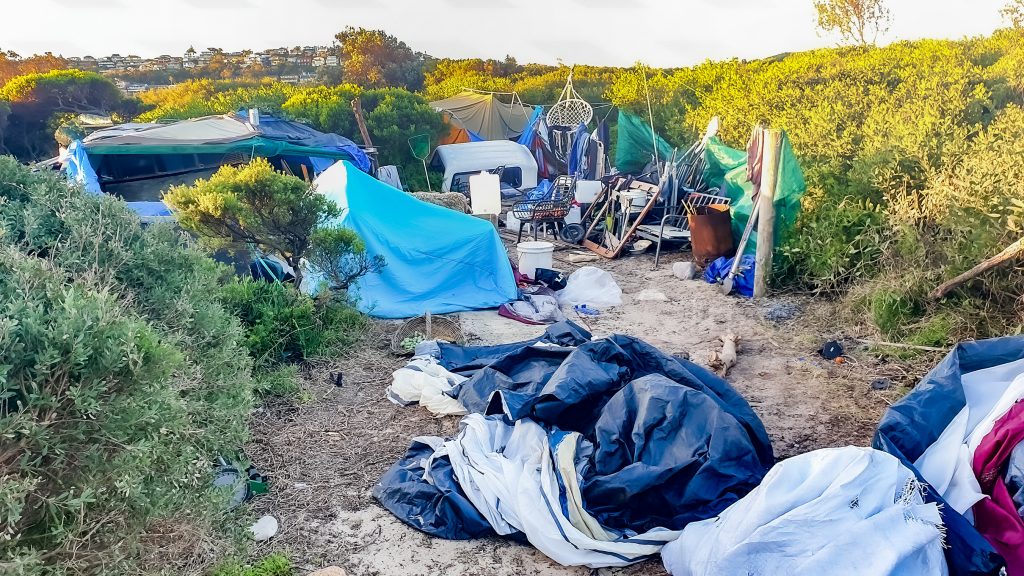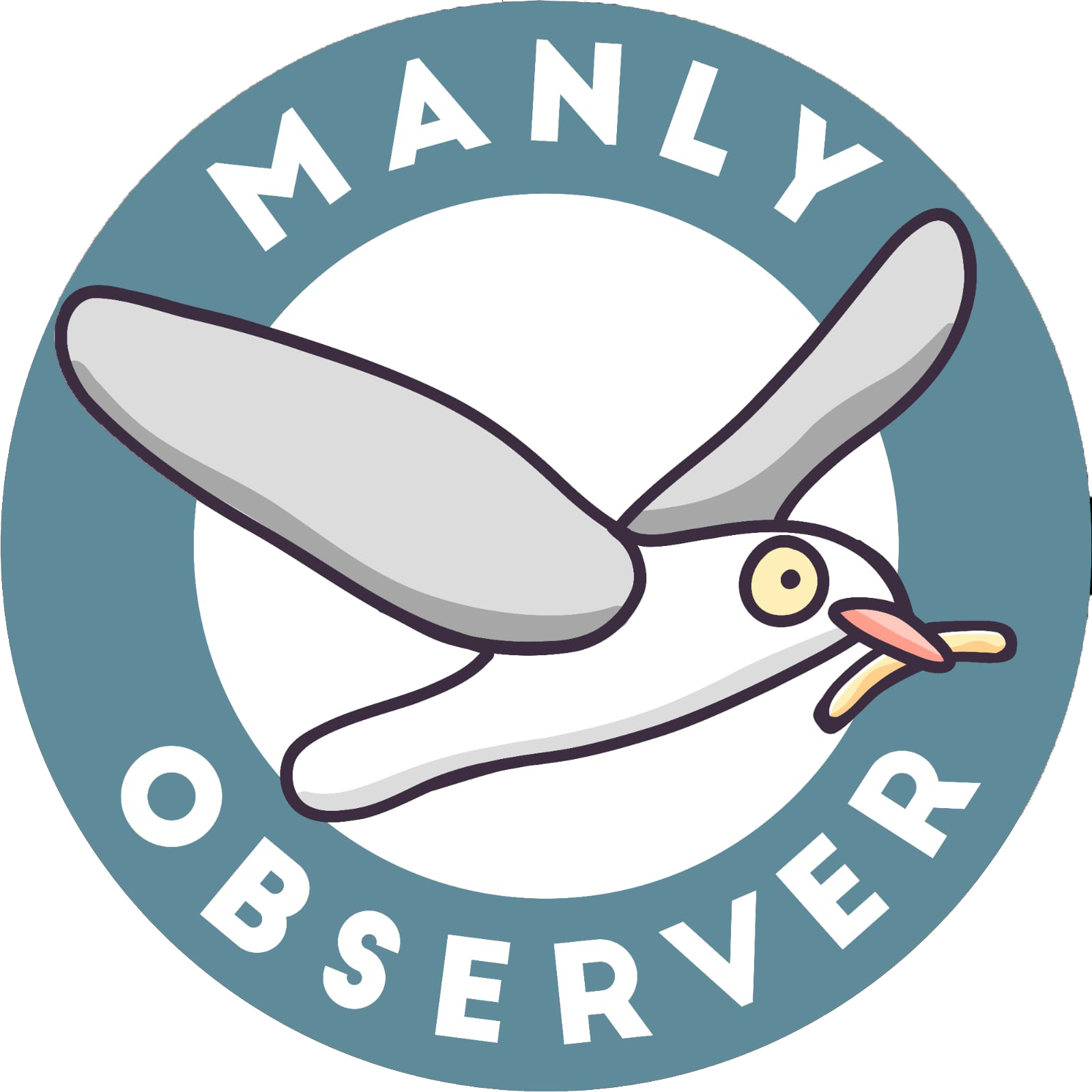Friends of Dee Why Lagoon (FoDYL), a volunteer group dedicated to improving the natural diversity of the tidal estuary on Dee Why seafront, was formed in 1980 to combat litter and regenerate the native bushland. Manly Observer caught up with president Margaret Lown and secretary Richard Michell, devoted carers of the lagoon’s environs, for a guided tour.
Dee Why seafront has been in the news lately, not least because there was a squatters’ camp occupying the dunes amidst the foliage between the beach and the lagoon – since cleared by authorities. Community concerns were raised when it became unclear whether the tarpaulin-shrouded encampments were occupied by homeless people in need of assistance or criminal elements pursuing unlawful activities.
Meanwhile, the area surrounding the camps became littered with all manner of human waste.
The FoDYL volunteers who, for decades, have removed plastic bags, bottles and discarded junk washed in through storm water channels or left by visitors, once again set to work removing mess.

Who are FoDYL?
According to the Dee Why Lagoon Wildlife Refuge Plan of Management (view online here), “in 1980, the community-based group Friends of Dee Why Lagoon was established with a focus on the environmental management of the refuge and its catchment.
“The Friends have initiated and participated in lagoon enhancement activities such as the annual ‘Clean-a-goon’ day, extensive bush regeneration projects, tree planting, dune revegetation and general litter clean ups.”
“I remembered one of the big litter problems in the early days was shopping trolleys,” Margaret recalled. “Before the gross pollution traps [were installed] in Hawkesbury and Avon drains, dozens of them ended up in the creeks. They were really hard to get out – a big job on our ‘Clean-a-goon’ days…”
FoDYL member Marie Taylor’s mother Ida was a founder member of the group and trained in the Bradley Method of bush regeneration, devised in the 1960s by sisters Joan and Eileen Bradley.
The Australian Association of Bush Regenerators reveals that this involves “methodically clearing small areas in and around healthy native vegetation so that each area is re-colonised by the regeneration of native plants, replacing the weeds.”
“Ida was the only member I’m aware of who had formal training in bush regeneration and was passionate about it,” Marie explained. “After being employed by the National Trust in this capacity at Dee Why Lagoon and other sites, she introduced the skills to the FODYL… I expect mum’s knowledge and guidance was significant in transferring skills and making a difference to the flora of the lagoon..”

Regeneration and rehabilitation
The lagoon and wetlands have been subdivided into six zones and FoDYL work with the Bushland Management of Northern Beaches Council to evaluate and oversee the planting of native flora and the removal of invasive species.
FoDYL’s stated aims are “dedication to the conservation and rehabilitation of the Lagoon waterbody and the surrounding Wildlife Refuge.” Conservation is maintenance and care (obviously), but what does ‘rehabilitation’ entail?
“Removing the non-native weeds to allow the native species to re-emerge,” Margaret explained. “Planting native species indigenous to the area.
“Dee Why Lagoon is situated in an extremely urbanised area and suffers from rubbish from people and non-native plants. You can’t control seeds being dropped by birds and blown by the winds. You also can’t control people throwing rubbish into the Wildlife Refuge.
“Some of our zones, for example zone D, were in-filled, which means there is not much of a native seed base. Hence the need for planting.”
In the 1960s, the south-eastern corner of Dee Why Lagoon, now known as James Meehan Reserve, was used as an industrial dump until Warringah Council covered the rubble with soil and grass and levelled it for a recreational field.
“The formation of James Meehan Reserve required that section of the wetlands to be filled in,” Margaret confirmed. “It was ‘clean’ construction material. The remains of an RSJ [rolled steel joist used in construction] can still be seen in our Zone D. Luckily it wasn’t turned into a tip as occurred at Curl Curl Lagoon.”

Elimination of invasive species
The Refuge Plan of Management report states that in “the early 1980s, the dunes of Dee Why beach were reshaped and planted with native species. The sustained efforts of the Friends of Dee Why Lagoon over a period of eight years almost completely eradicated bitou bush infestation of the dune system.”
Bitou bush is a highly invasive weed, originally from South Africa, that the Department of Primary Industries describes as “primarily invades coastal dune systems” where it “displaces the dominant plants in communities it invades.”
From 1946-1968 Bitou was “planted deliberately along the NSW coast by the Soil Conservation Service of NSW to aid in erosion control and post-mining rehabilitation.” Since then it has proliferated, replacing native plants whilst destroying the habitats of Australian wildlife.
FoDYL also remove other invasive weeds that permeate the wildlife refuge. However, Margaret and Richard revealed that Council’s mowing of the grass around James Meehan Reserve routinely hurls non-native seeds into the adjacent bushland sanctuary and needs better containment barriers.
Protection of the water is also a high priority. “It’s a major challenge because of the sedimentation,” Margaret revealed – dirt that flows in from stormwater channels and silts up the lagoon. Much of this comes from building sites in the Dee Why Town Centre, which, FoDYL assert, are not being properly monitored and regulated.
Website: https://fodyl.au/
Facebook: https://www.facebook.com/Friends-of-Dee-Why-Lagoon-153332268406655
Email: friends@fodyl.au
Friends of Dee Why Lagoon work actively in bush re-generation every Thursday morning from 7am – 9am.
Dee Why Lagoon Plan of Management (Northern Beaches Council)

What are Dumble stops?
Incidentally, in the south-eastern corner of Dee Why Lagoon, jutting out of the water and obscured by marsh reeds, lies a dual row of 22 rotting timber staves. Known as “Dumble Stops” and resembling a ruined jetty, these forlorn stumps are among the last of Australia’s World War 2 sea defences still in place.
Although there were military fortifications in place between Port Stephens and Port Kembla, including anti-submarine boom nets and anti-aircraft guns, after the Japanese military attacks on Sydney in May and June 1942, further shoreline defences were installed.
Between Fairy Bower Beach, Manly, and Palm Beach, 300 “dragon’s teeth” (concrete pyramids weighing 2 tonnes apiece), were placed along the shoreline to deter tanks alighting from landing craft.
These were complimented by iron stakes, interlocked steel scaffolding ‘hurdles’, rolled barbed wire and the aforementioned timber ‘Dumble stops’, which were driven into the beds of seaside lagoons, tidal lakes and creeks from North Head to Newcastle.
As well as Dee Why Lagoon’s Dumble stops, a single dragon’s tooth still sits among the mangroves at Bayview, opposite 1961 Pittwater Rd, routinely submerged by incoming tide.




